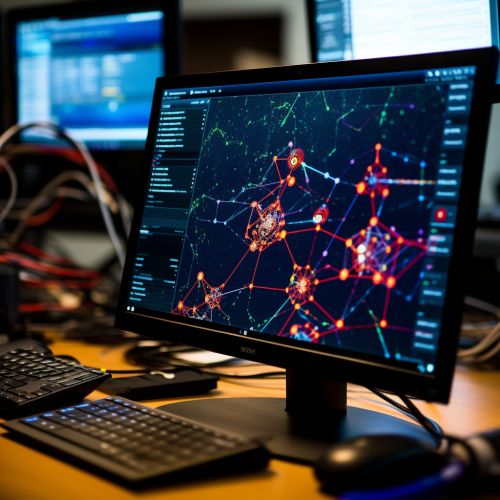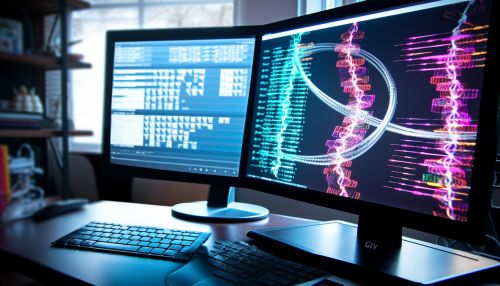Computational biology
Introduction
Computational biology, also known as bioinformatics, is an interdisciplinary field that applies computational methods to analyze large collections of biological data, such as genetic sequences, cell populations or protein samples, to make new predictions or discover new biology. The computational methods used include analytical methods, mathematical modeling and simulation 1(https://www.ncbi.nlm.nih.gov/pmc/articles/PMC5795969/).


History
The term "computational biology" was first used in the late 1980s, but the concept of using computers to assist in biological research dates back much further. In the 1960s and 1970s, some of the earliest applications of computers in biology included the development of algorithms for aligning DNA sequences, which is still a major focus of computational biology today 2(https://www.ncbi.nlm.nih.gov/pmc/articles/PMC2926809/).


Methods
Computational biology involves the development and application of data-analytical and theoretical methods, mathematical modeling and computational simulation techniques. The field is broadly defined and includes foundations in biology, applied mathematics, statistics, biochemistry, chemistry, biophysics, molecular biology, genetics, genomics, computer science, and evolution 3(https://www.ncbi.nlm.nih.gov/pmc/articles/PMC2926809/).
Data Analysis
One of the key aspects of computational biology is the analysis of biological data. This can involve raw data cleaning, statistical analysis, and complex algorithmic data processing. Some of the most common types of data analyzed in computational biology include DNA sequences, protein sequences, and large-scale population data 4(https://www.ncbi.nlm.nih.gov/pmc/articles/PMC2926809/).


Mathematical Modeling
Mathematical modeling is a critical tool in computational biology. It allows researchers to create theoretical scenarios that can be tested and validated against real-world data. This can help to predict future outcomes or understand complex biological systems 5(https://www.ncbi.nlm.nih.gov/pmc/articles/PMC2926809/).


Simulation Techniques
Simulation techniques are another key aspect of computational biology. These techniques allow researchers to simulate biological systems, such as cell populations or protein interactions, in order to test hypotheses or understand biological processes 6(https://www.ncbi.nlm.nih.gov/pmc/articles/PMC2926809/).


Applications
Computational biology has a wide range of applications in many areas of biology, medicine, and biotechnology. These include genomics, proteomics, structural biology, evolutionary biology, systems biology, bioinformatics, and more 7(https://www.ncbi.nlm.nih.gov/pmc/articles/PMC2926809/).
Genomics
In genomics, computational biology is used to sequence and analyze the function and structure of genomes (the complete set of DNA within a single cell of an organism). This includes the analysis of gene sequences and their functions, as well as the structures of entire genomes and their relationships to each other 8(https://www.ncbi.nlm.nih.gov/pmc/articles/PMC2926809/).


Proteomics
In proteomics, computational biology is used to analyze the structure and function of proteins. This includes the analysis of protein sequences, structures, and interactions, as well as the prediction of protein function based on sequence and structural information 9(https://www.ncbi.nlm.nih.gov/pmc/articles/PMC2926809/).
Structural Biology
In structural biology, computational biology is used to analyze the three-dimensional structure of biological macromolecules, such as proteins and nucleic acids, in order to understand their function and design drugs to interact with them 10(https://www.ncbi.nlm.nih.gov/pmc/articles/PMC2926809/).
Evolutionary Biology
In evolutionary biology, computational biology is used to analyze the origins and evolution of species. This includes the analysis of genetic data from various species to understand their relationships and the history of life on Earth 11(https://www.ncbi.nlm.nih.gov/pmc/articles/PMC2926809/).
Systems Biology
In systems biology, computational biology is used to analyze complex biological systems. This includes the analysis of interactions within cells and between cells, as well as the analysis of the behavior of entire biological systems 12(https://www.ncbi.nlm.nih.gov/pmc/articles/PMC2926809/).
Future Directions
The future of computational biology is likely to involve the development of new computational methods and tools, as well as the application of these methods to new areas of biology. This could include the development of more accurate and efficient algorithms for analyzing biological data, as well as the application of computational biology to areas such as personalized medicine, synthetic biology, and more 13(https://www.ncbi.nlm.nih.gov/pmc/articles/PMC2926809/).
See Also
References
1. "Computational biology and bioinformatics in the era of post genomics" 2. "Computational biology in the 21st century" 3. "Computational biology: A modern approach to biology" 4. "Data analysis in computational biology" 5. "Mathematical modeling in computational biology" 6. "Simulation techniques in computational biology" 7. "Applications of computational biology" 8. "Genomics and computational biology" 9. "Proteomics and computational biology" 10. "Structural biology and computational biology" 11. "Evolutionary biology and computational biology" 12. "Systems biology and computational biology" 13. "Future directions in computational biology"
